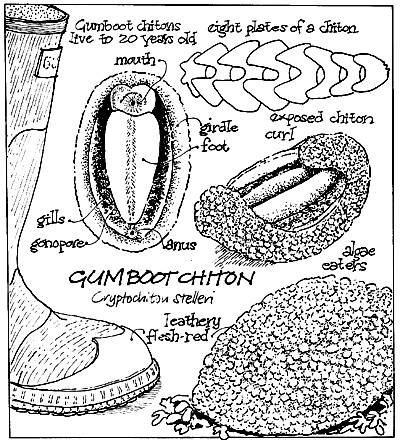Radula: A flexible tonguelike organ in certain mollusks, having rows of horny teeth on the surface. [Latin r dula, scraper, from r dere, to scrape] freedictionary.com
The Gumboot Chiton is not pretty, and is downright ugly when turned over. The rows of molars on its underside are wonderfully suited though, to scraping algae off rocks, and the hardness of its dentures is something materials scientists study closely. The Chiton, described as a “wandering meatloaf” because of its hump of leathery brown upper skin, may not have an alluring personality, but is teeth are magnetic, leading to University of California, Riverside assistant professor David Kisailus’ attraction to them.
Kisailus, specializing in chemical and environmental engineering, and his fellow researchers may have found lessons in nature, and in the mouth of this marine snail, “to create less costly and more efficient nanoscale materials to improve solar cells and lithium-ion batteries,” according to the University.
Up to a foot long, “Chitons have evolved to eat algae growing on and within rocks using a specialized rasping organ called a radula, a conveyer belt-like structure in the mouth that contains 70 to 80 parallel rows of teeth. During the feeding process, the first few rows of the teeth are used to grind rock to get to the algae. They become worn, but new teeth are continuously produced and enter the “wear zone” at the same rate as teeth are shed,” as noted in the University’s press release.
Kisailus started studying chitons five years ago because of his interest in abrasion and impact-resistant materials, having found previously that chiton teeth contain the hardest biomineral known on Earth. Magnetite in the chiton’s choppers makes the teeth hard, and magnetic.
In the just-published paper, “Phase transformations and structural developments in the radular teeth of Cryptochiton stelleri,” Kisailus and his research team describe how the chiton’s teeth form, a three step lesson in biomimicry of import to those developing batteries and solar cells, oddly enough.
- Hydrated iron oxide (ferrihydrite) crystals nucleate on a fiber-like chitinous (complex sugar) organic template.
- These nanocrystalline ferrihydrite particles convert to a magnetic iron oxide (magnetite) through a solid-state transformation.
- Finally, the magnetite particles grow along these organic fibers, yielding parallel rods within the mature teeth that make them so hard and tough.
Kisailus explains, “Incredibly, all of this occurs at room temperature and under environmentally benign conditions. This makes it appealing to utilize similar strategies to make nanomaterials in a cost-effective manner.” Lower temperatures usually require less overall energy, lowering costs for next-generation products.
He’s applying these lessons in his lab to control the crystal size, shape and orientation of engineering nanomaterials that would lead to more efficient solar cells and faster-charging batteries.
Other potential applications include materials for car and airplane frames, abrasion resistant clothing, and could provide design parameters for better oil drills and dental drill bits – the last a bit of poetic recursiveness.
UC Riverside says, “The paper was published January 16 in the journal Advanced Functional Materials. It was co-authored by several of his current and former students and scientists at Harvard University in Cambridge Mass., Chapman University in Orange, Calif. and Brookhaven National Laboratory in Upton, NY.
“Co-authors of the Advanced Functional Materials paper were: Qianqian Wang, Michiko Nemoto, Dongsheng Li, Garrett W. Milliron, Brian Weden, Leslie R. Wood, all of whom are current or former undergraduate and graduate students at UC Riverside; James C. Weaver, a former post-doc of Kisailus, now at Harvard University; John Stegemeier and Christopher S. Kim, of Chapman University; and Elaine DiMasi, of Brookhaven National Laboratory.”

